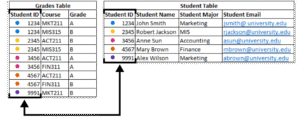Introduction to Relational Databases
Relational databases are one of the most widely used data storage systems in the world. They organize data into structured formats using tables, making it easy to retrieve, manipulate, and manage information through a standard language—SQL (Structured Query Language). This module introduces students to the foundational principles and components of relational databases, setting the stage for deeper exploration into SQL.

1. What is a Relational Database?
A relational database stores data in tables, also called relations, where each table contains rows (records) and columns (fields). Each table focuses on a specific subject—like customers, products, or orders—and is linked to others through relationships. These relationships allow users to query multiple tables at once, providing a comprehensive view of the data.
2. Key Components of a Relational Database
To fully understand relational databases, students should grasp the following:
- Tables: The core structure where data is stored.
- Rows (Tuples): Each row represents a single record or entry.
- Columns (Attributes): Each column represents a data field or property.
- Primary Keys: Unique identifiers for each row within a table.
- Foreign Keys: References that create links between different tables.
This structure makes relational databases highly organized and ensures data consistency and integrity.
3. Advantages of Relational Databases
Relational databases are widely adopted because of several benefits:
- Data Integrity: Enforced through primary and foreign keys.
- Scalability and Flexibility: Easy to scale and modify without losing structure.
- Security: Allows user access control to protect sensitive data.
- Query Power: Enables complex queries through SQL to gain insights.
This model is ideal for systems that require structured data and complex querying, such as banking, e-commerce, and CRM systems.
4. Real-World Use Cases
Students should understand where relational databases are commonly used:
- Online retail systems managing products, orders, and customer data.
- Banking applications storing transaction records and customer details.
- Inventory systems tracking stock levels and supplier information.
Understanding the relational database model helps students appreciate why SQL is such a powerful and essential tool in the world of data.